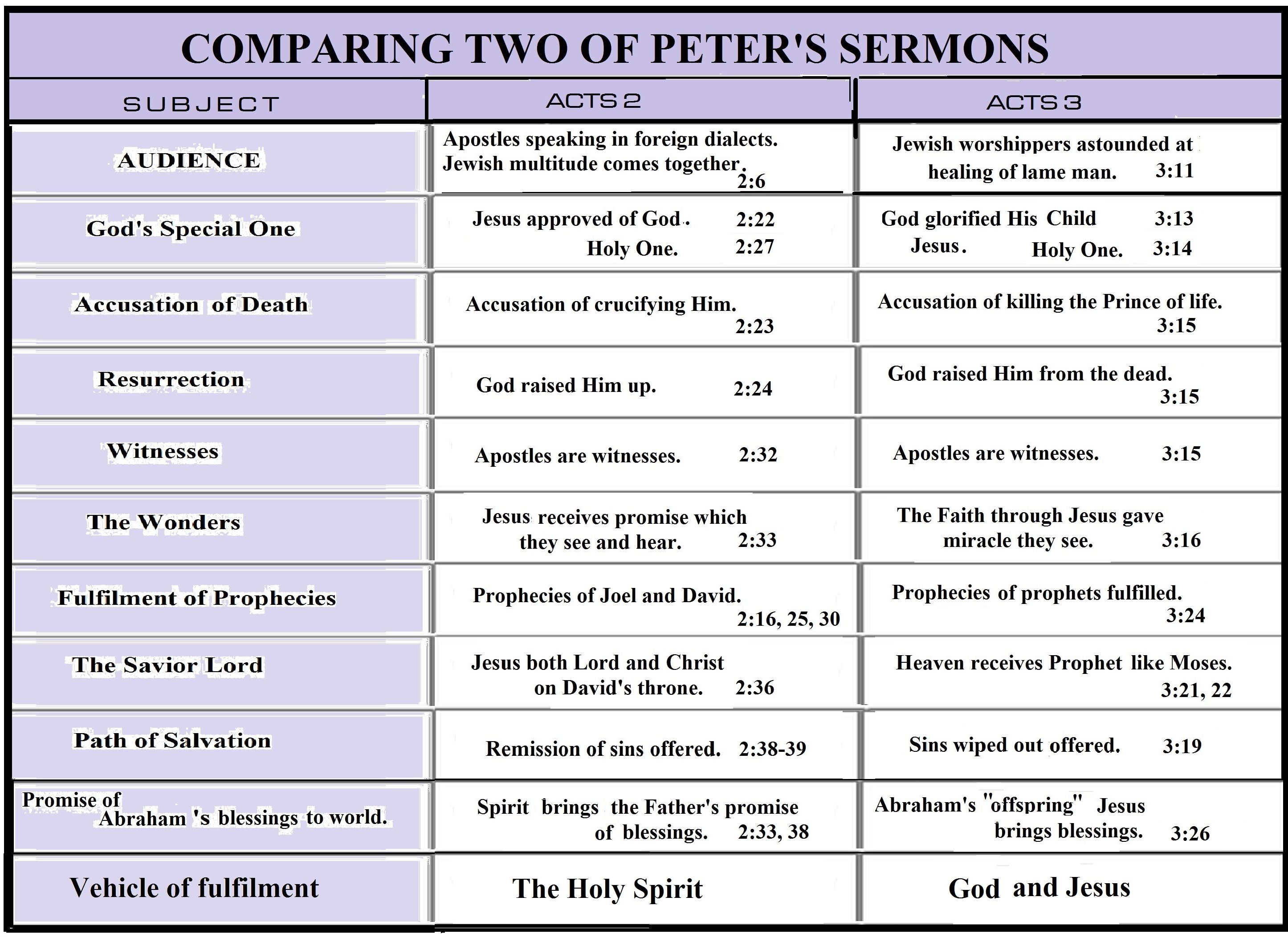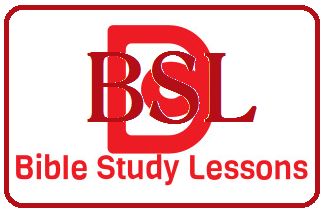Misinterpretation of Acts 5:32 |
|
Acts 2 records the first NT gospel sermon and the text above describe in general terms the subsequent state of the believers. The next recorded sermon is in Acts 3. Since the “getting the gift of the Holy Spirit” in the first sermon is controversial, one would expect to examine the next sermon and compare each with hope of resolving any linguistics problem.
There's a true axiom, “When there's a problem, let the Bible interpret itself.” It seems reasonable to me that if there is a parallel report like passages on Jesus's comment on God's giving of the Spirit (Matthew 7:11; Luke 11:13), why not let each be a commentary on the other? Although the events in Acts 2 and Acts 3 occur at different times, they cover the same thing. It's still Joel's prophecy on how to "call on the name of the Lord" to be saved" (Acts 2:21).
I propose that the events and each sermon content are parallel (except for order) and in that sense it can be said to be the same teaching in both Acts 2 and Acts 3. Howbeit, there are a couple of significant variation. Observe what the similarities. Each begins with a miracle that occurs to authenticate the apostles as God's spokesmen. (1) Peter is the same preacher. (2) Both sermons appeal to the Old Testament prophets. (3) Jesus is surely the central focus of both sermons. (4) The audience is offered means for forgiveness of their sins. [See chart]. Summary of the Sermon. Peter immediately begins by mentioning God's glorifying His Servant Jesus (v. 13) who is the Holy and Righteous One (v.14), the Author of life (v. 15), healing is through Jesus (v.16), God prophesied of Jesus (18,20), refreshment from Christ Jesus, the Lord (v. 20), Jesus is a prophet like Moses (v. 22), the Abraham's Offspring of blessings to all, and He is God's Servant (v. 26). Although in both sermons Peter identifies Jesus as "the man" (Acts 2:22) and God's "servant" (Acts 3:13, 16) and "prophet like Moses" (Acts 3:22), his conclusion in Acts 2 (vv. 30, 34) is that Jesus sits at God's right hand and, in Acts 3, He is raised and God has glorified Him (vv. 13,15).
Variation 1: Vehicle of Delivery. The deity's role is mentioned in a different framework. Acts 2 designates all the members of the Trinity working in respective roles: it names God as the Father and source (v.33), the Spirit as God's medium (v.17), and the man Jesus as God's Holy One who dies, is raised and is made the Lord, the Christ (v. 27, 36). The assignment to the Trinity reminds us of the commission of Jesus to the apostles to teach all nations and baptize “in the name” (singular “name” and hence, oneness) “of the Father, the Son, and the Holy Spirit” (Matthew 28:19).
A Different Message Offered in Acts 3? If one wonders why no one today seems to go to Acts 3 to support their modern spirit doctrines, whether it be their views on “baptism of the Holy Spirit” or “Spirit illumination”, the answer may be because the word “spirit” does not occur in Acts 3's event. That's right. The seemingly significant subject of “spirit” to these intellectuals is not there. Peter is not recorded as mentioning the Spirit at all. One must wonder why this is so because (1) the preacher is the same, (2) the audience is the same (Temple worshippers and “murderers”), (3) the message is the same, and (4) the response is the same (believers do result, Acts 4:4). Is there a different doctrine of the deity delivered on this occasion? Our proposition of the character of God would require a negative answer.
This has to be true because the character of God of the Bible demands it. For example, (1) “For I am the LORD, I do not change” (Malachi 3:6); (2) “...the Father of lights, with whom there is no variation or shadow of turning” (James 1:17). “If God is constant and His Word interprets itself, the corollaryi principle is that the Bible's interpretation of its symbols is consistent.” ii “One cannot look at one passage or verse in a vacuum.”iii
First of all, Peter explains the miracle of the event as fulfilment of Joel's prophecy which identified the vehicle function of the Spirit. Second, Joel's prophecy is not used because it says nothing about healing the lame. Prophecies used in chapter 3 attributes all to God and Jesus. The harmony is in the Trinity's unity. This should remind us that whatever the Spirit eventually does in chapter 2 or anywhere originated with the Father and His Son Jesus. Hence, any blessings of the Spirit are of God, the Father, and Jesus; i.e., the “gift of the Holy Spirit” would be “the gift of God” or “the gift of Jesus Christ.” It would be difficult to sever the close relationship of their nomenclature and not do violence to the Scriptures.iv
Secondly, the Godhead is usually referred to by one of the Divine Persons. Two Scriptures that demonstrate the use of one to stand for the other/s: “Wherefore be ye not unwise, but understanding what the will of the Lord is. And be not drunk with wine, wherein is excess; but be filled with the Spirit; Speaking to yourselves in psalms and hymns and spiritual songs...” (Ephesians 5:17-19a). Its parallel passage: “Let the word of Christ dwell in you richly in all wisdom; teaching and admonishing one another in psalms and hymns and spiritual songs...” (Colossians 3:16a). The “will of the Lord”=“filled with the Spirit”=“word of Christ dwell.”
Thirdly, the miraculous event is different. Therefore, we conclude that although the Spirit was working in both events, the circumstance of quoting Joel's prophecy required Peter to speak of the Spirit as the active Divine Person, Peter had no cause to differentiate the Persons of the Trinity in the second sermon (Acts 3).
We now investigate an apparent difference in the steps of salvation given in both chapters as we continue with this mystery. We have diagrammed Acts 2:38*; we will diagram Acts 3:19, 20. * “Getting the Spirit” (Acts 2:38) #2 in link below. Throw Out the Lifeline Other articles in this series, The Gift of the Holy Spirit: > i corollary: “forming a proposition that follows from one already proved” (Oxford Dictionary). ii https://www.bibletools.org/index.cfm/fuseaction/Topical.show/RTD/CGG/ID/2023/Bible-Interprets-Bible.htm iii http://hermeneutics.stackexchange.com/questions/79/what-does-it-mean-that-scripture-interprets-scripture iv The equivalency of the Trinity “gift by grace is by Jesus Christ” (Romans 5:15); “the gift of God is eternal life through Jesus Christ” (Romans 6:23); “the measure of the gift of Christ” (Ephesians 4:7). Jesus has the power to give “the gift of God” (John 4:10); the giving of the miraculous power of the Holy Spirit by the hands of the apostles is called “the gift of God” (Acts 8:20); Paul had the gift of the grace of God (Ephesians 3:7); Timothy's gift by Paul's hand was of God (1 Timothy 1:6). In Romans 8:9, the Spirit is called both “the Spirit of God” and “the Spirit of Christ.” All three are referenced together, such as the sake of Christ, the love of the Spirit, and prayers to God (Romans 15:30). God is “of our Lord Jesus Christ” and “the Father of glory” and giver of “the Spirit of Wisdom and Revelation” (Ephesians 1:17). Philippians 3:3; Hebrew 9:14; 1 Peter 1:2; 3:18; 4:14; 1 John 4:2, 3. |

